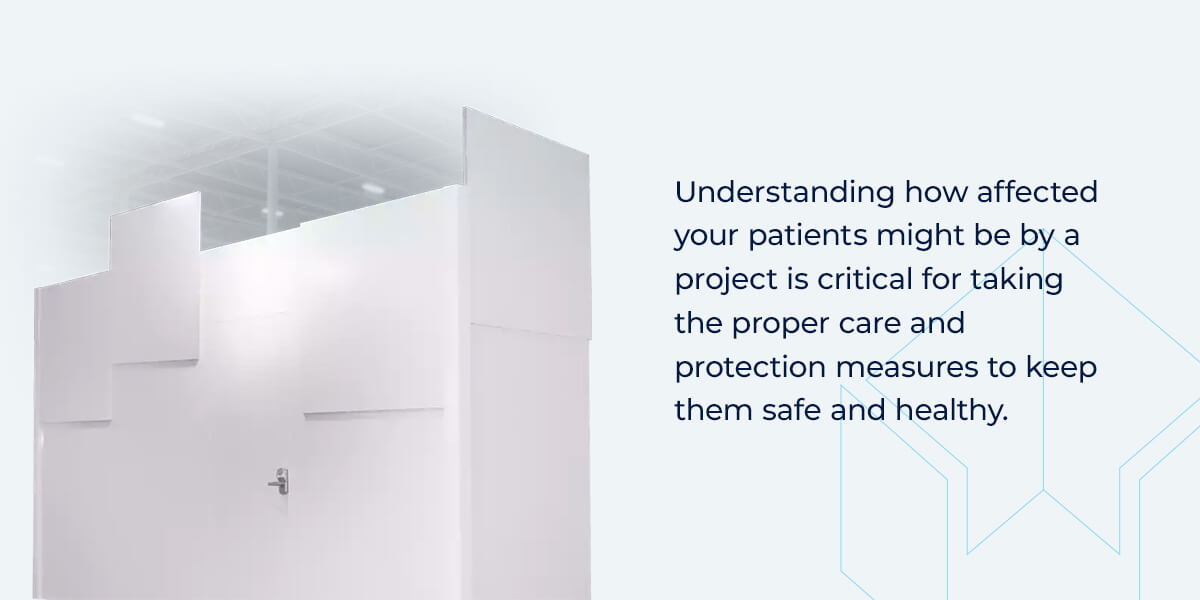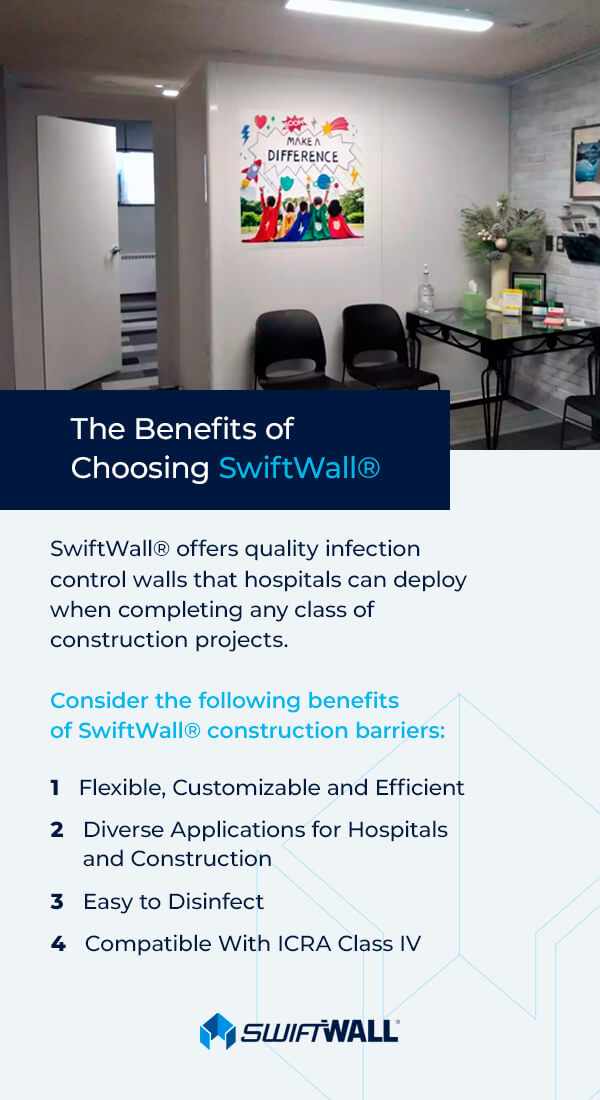Hospital and healthcare facility safety is imperative. As treatment centers for various conditions and illnesses, hospitals and staff must do everything they can to maintain proper facility conditions that promote and support healing and recovery. Construction can offer unique challenges to these goals, but using the appropriate standards and tools can help preserve hospital performance and patient care.
What Is ICRA?
The Infection Control Risk Assessment (ICRA) is a set of guidelines and strategies hospitals and other healthcare facilities can implement to increase health and safety for patients and employees. It allows hospitals to assess every possible risk and source of contamination. When your hospital undergoes renovations, you can use infection control during construction to maintain regular hospital conditions.
Why Is ICRA Important?
Healthcare renovation infection control is necessary during the construction process. ICRA standards provide comprehensive protection that covers the following:

Air Quality
Construction projects can leave particles in the air from cutting materials and using building substances. Under normal conditions, people can inhale them without much consequence. However, hospital patients are already at higher risk of respiratory infections and other diseases. Hospitals must maintain proper air quality levels to ensure safety and provide patients with conditions to aid their recovery. ICRA standards help meet those standards by preventing dust and debris from entering airways and causing health concerns.
Surface Conditions
Construction debris and dust often collect on multiple surfaces. With many employees and patients moving around hospitals, maintaining proper sanitization and disinfection procedures is critical to prevent the spreading of germs. ICRA includes practices to tackle these challenges so spaces are clean and safe after construction.
Cross-Contamination
While construction might be confined to one area, HVAC systems and moving people can cause particles and germs to travel outside construction zones. Following ICRA standards allows hospitals to develop comprehensive containment methods so that people can travel as needed and systems can run in other parts of facilities for optimal comfort and care.
When renovation and building projects might be vital for hospital performance and functionality, adhering to ICRA standards ensures you can continue providing excellent care throughout the duration of construction.
How to Approach Hospital Construction With ICRA Guidelines in Mind
Hospital ICRA guidelines keep patient needs and safety in mind, so you can complete your renovation of healthcare facilities efficiently. The following steps can simplify the construction preparation process and help you identify what your hospital must do to improve health and safety.
1. Decide Construction Project Type
When redesigning hospitals per ICRA guidelines, your safety and protection procedures will depend on the type of work you must do. ICRA defines various projects by intensity and invasiveness, allowing hospitals to understand how they will impact patients. The project types include the following:
- Type A: Type A projects are non-invasive and will produce minimal dust and debris. These projects are incredibly minor, often meaning regular maintenance or preventive measures for other issues. Some examples include removing individual tiles for quality inspections, painting without sanding and minor plumbing.
- Type B: Type B will increase the project scope slightly. These projects might have a longer duration and are more invasive, but they will still result in minimal dust production and are less comprehensive. Type B projects might include cutting into walls and ceilings or installing cables.
- Type C: This type marks the entry into demolition and removal projects, increasing their scope and impact on patients. They involve work on fixed building components and will produce significant dust. Type C projects will often take longer to complete, resulting in several shifts dedicated to construction. Projects may include sanding walls, removing flooring and tiles, completing electrical or ductwork in ceilings, building new walls and adding major cable runnings.
- Type D: The final type is the most comprehensive and invasive. Type D projects include major demolition and building projects that require several consecutive shifts. They will produce the most dust and debris, requiring more preventive measures from hospitals to protect patients. Type D projects could include adding new cable systems throughout the entire hospital or wing.
Understanding your construction project type is essential when planning preventive measures and meeting ICRA requirements.

2. Identify Patient Risk Type
After understanding your project type, you will need to determine who it will impact. Each project will have a different risk level depending on where construction will take place and who interacts with those areas. Understanding how affected your patients might be by a project is critical for taking the proper care and protection measures to keep them safe and healthy.
ICRA separates risk types by various spaces in hospitals and patient conditions. Different departments will often determine patient risk levels for increased understanding. The ICRA risk levels are as follows:
- Low risk: Low-risk areas include office and administrative spaces. Only hospital employees occupy these spaces, making it easier to keep dust and debris from impacting patients. However, hospitals will still need to take precautions to ensure employees moving between offices and patient wards don’t carry particles.
- Medium risk: Medium-risk areas will increase patient interactions but often include spaces where they are coming and going rather than staying for long periods. These areas cover various departments, including cardiology, radiology, physical therapy, endoscopy, echocardiology, nuclear medicine, physical therapy and respiratory therapy.
- High risk: High-risk spaces will include more constant care for patients in more critical and vulnerable conditions. They could include the emergency room, labor and delivery floors, newborn nurseries, pediatrics, critical care unit, surgical units and post-anesthesia units. Hospitals should also count their specimen labs and pharmacies as high-risk areas.
- Highest risk: These spaces and patients require the most care and protection. They will often already have more precautions during regular operations to keep patients safe and healthy during treatment and recovery. The highest-risk areas will include any location with immunocompromised patients. However, other specific spaces include burn units, intensive care units, oncology departments, negative pressure isolation rooms and all operating rooms, along with those reserved for C-sections. Hospitals should also mark their cardiac cath labs and central sterile supply spaces as the highest risk.
Knowing how at-risk your patients are will help you keep them safe during healthcare facility construction. When construction is essential for hospital functionality and efficiency, knowing how it will impact patients can help you provide better care and recovery.
3. Determine Classification Level
ICRA classifications are the meeting point between project type and risk level. Classification level will determine the construction practices you put in place to keep patients safe while efficiently completing projects. After determining your project type and risk level, you can learn your project’s classification type.
The ICRA classifications are as follows:
- Class I: Class I specifications will include low-, medium- and high-risk patients for type A projects. Their minimally invasive specifications make them safer for more patients.
- Class II: Class II crosses multiple project types and risk levels. It starts with the highest-risk patients under project type A and includes low-, medium- and high-risk patients for project B types. Low-risk levels for project type C will also fall under class II.
- Class III: Class III is more comprehensive and shares many categories with class IV because of patient risk and project severity. Both classes have similar strategies, so many hospitals upgrade class III to class IV to optimize protection. This class will include the highest risk levels with project B. Under project type C, it will cover medium-, high- and highest-risk patients. Finally, low-risk levels for project type D will qualify as this classification level.
- Class IV: Class IV exists when you want to offer the best protection and care for your patients and spaces in your hospital. Only the highest risk level for project type B will be a class IV. For project type C, you will include high-risk and highest-risk patients. All project D types fall under class IV categorization because of their more comprehensive and invasive nature.
Knowing your classification type is essential for implementing safety strategies and protective measures. When your classification depends on your patient risk levels and project type, using ICRA standards to determine where your project falls will prevent patients from contacting dust and debris that can disrupt their healing process.
4. Apply Proper Classification Safety Strategies
After determining your project’s classification type, you can begin to integrate the right protective strategies. Each classification will add more protection and safety standards to accommodate increased dust production and higher patient risks.
Class I Projects
Because class I projects will produce minimal dust and debris, hospitals will require few measures when completing these projects. Staff and workers will need to clean up after work. Be sure to wipe up any dust, remove waste and sanitize affected surfaces.
Class II Projects
Class II projects create more debris and affect at-risk patients, resulting in more comprehensive procedures that hospital employees and construction employees can follow. Practices to implement before, during and after class II projects include:
- Misting surfaces with water to simplify clearing dust that gathers there.
- Confining dust to working spaces by sealing doors, vents and other entryways with tape or other materials.
- Adding dust mats at entrances to ensure no one tracks debris to other areas.
- Isolating or removing HVAC systems to further prevent debris from spreading.
- Disinfecting surfaces and putting waste in sealed containers before exiting areas.
- Cleaning rooms by sanitizing with mops and vacuuming with HEPA-filtered equipment.
- Reinstalling HVAC systems only after all other cleaning measures.
Class III Projects
Class III projects require more attention to detail and preparation. These project types are more extensive and might take longer, so hospitals must rely on safety measures to maintain patient health and safety standards throughout their duration. Strategies for class III projects include:
- Sealing spaces and removing or isolating HVAC systems like with class II projects.
- Adding barriers and maintaining a negative air pressure with HEPA filters to further prevent cross-contamination.
- Placing waste in sealed and covered containers before removing it from construction zones.
- Inspecting everyone before entering and exiting construction spaces.
- Vacuuming with HEPA filters and sanitizing and disinfecting surfaces with mops.
- Receiving cleaning services from your hospital’s Environmental Services department.
- Having your hospital’s Safety and Infection Prevention and Control departments inspect construction zones before removing barriers and seals.
- Reinstalling HVAC systems after clearing inspections and meeting cleaning standards.
Class IV Projects
Class IV standards build on those from class III to provide more protection for your highest-risk patients and bigger projects. The safety procedures for this classification include:
- Sealing vents and doorways and removing or isolating the HVAC system.
- Establishing appropriate barriers.
- Implementing a negative air pressure with HEPA air filters.
- Preventing contamination outside construction zones with anterooms where people get vacuumed by HEPA-filtered vacuums before entering and exiting.
- Requiring employees to wear shoe covers each time they enter spaces.
- Sanitizing and disinfecting with mops and vacuums.
- Removing waste from premises in sealed and covered containers.
- Getting thorough cleaning services from the Environmental Services department.
- Keeping barriers and seals in place until after passing inspections from the Safety and Infection Prevention and Control departments.
- Reinstalling HVAC systems and unsealing spaces.
Your hospital’s actions and decisions to protect patients can help reduce the risk of respiratory infections and illnesses. When your hospital needs to perform repairs or upgrade areas, you can count on ICRA safety standards to keep your patients safe while completing projects.

The Benefits of Choosing SwiftWall®
Hospitals can leverage barriers and temporary walls in several ways during construction projects to support ICRA standards and practices. SwiftWall® offers quality infection control walls that hospitals can deploy when completing any class of construction projects. Consider the following benefits of SwiftWall® construction barriers:
1. Flexible, Customizable and Efficient
SwiftWall® solutions are easy to install and remove to streamline preparation and cleaning processes for hospital teams. Efficiency at every stage speeds up the completion process so you can enjoy a fully functional hospital once more. With various models and adjustable heights, your SwiftWall® solutions can fit your hospital’s needs for more security and safety.
2. Diverse Applications for Hospitals and Construction
SwiftWall® can provide several temporary wall solutions for healthcare facilities. You can use them to temporarily separate areas, from offices for administrative work to family rooms and breakout treatment centers. Their easy implementation and removal capabilities make them great for adjusting to current and unexpected needs.
For construction projects, you can use SwiftWall® to create barriers and anterooms between work zones and other hospital areas. These solutions allow you to separate contaminated sites, keeping patients and employees safe from dust particles.
3. Easy to Disinfect
Cleaning and sanitizing are essential parts of following ICRA guidelines. Whether working with a class I or class IV project, you must thoroughly sanitize and disinfect areas before removing barriers and opening them back up to patients and workers. SwiftWall® designed our solutions with materials compatible with the most common disinfectants and cleaners for efficient post-construction processes.
Because they are easy to clean, you can reuse these hospital construction barrier walls. Their flexible configuration allows you to use custom setups each time, but the ability to sanitize them ensures you can provide clean services, regardless of their future function.
4. Compatible With ICRA Class IV
Maintaining the Hospital Environment Clean Construction (H.E.C.C.) protocols will allow for construction to continue until the project is completed. When installed properly, SwiftWall® Flex matches the qualifications for ICRA class IV projects. They can effectively contain substances and debris for improved safety in the most extreme and critical circumstances. Sanitization ensures proper health and safety applications. SwiftWall® solutions have negative air capabilities, supporting negative air pressure in construction zones.

Request a Free Quote From SwiftWall® Today
When you want to meet ICRA guidelines for your hospital construction needs, SwiftWall® solutions can help meet your applications and standards. With simplicity and durability in mind, SwiftWall® developed various temporary wall options your hospital can implement in different ways to support safety standards.
Request a free quote today and discover how SwiftWall® can create more flexible and clean spaces in your hospital.


